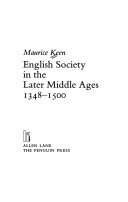Penguin Social History of Britain S.
1 total work
In 1350 the traditional idea of the "three estates" - priests, knights and labourers - offered an idealized but essentially accurate picture of society. By 1500 a far more complex structure based on landowning wealth, the city commercial elite and "bastard feudal" relations was firmly in place. In this book, Maurice Keen traces the causes and scope of this great transformation by looking in turn at the development of each "estate". He considers the spread of literacy, the terrible devastation wrought by the Black Death (1348-9), the mercantile growth of London alongside the royal court at Westminster, and the new systems of taxation and administration created by the Hundred Years War (1337-1453). These crucial factors influenced popular and clerical religion, country life, and even the households of the aristocracy. Keen draws on a range of evidence and explores many unexpected connections.
